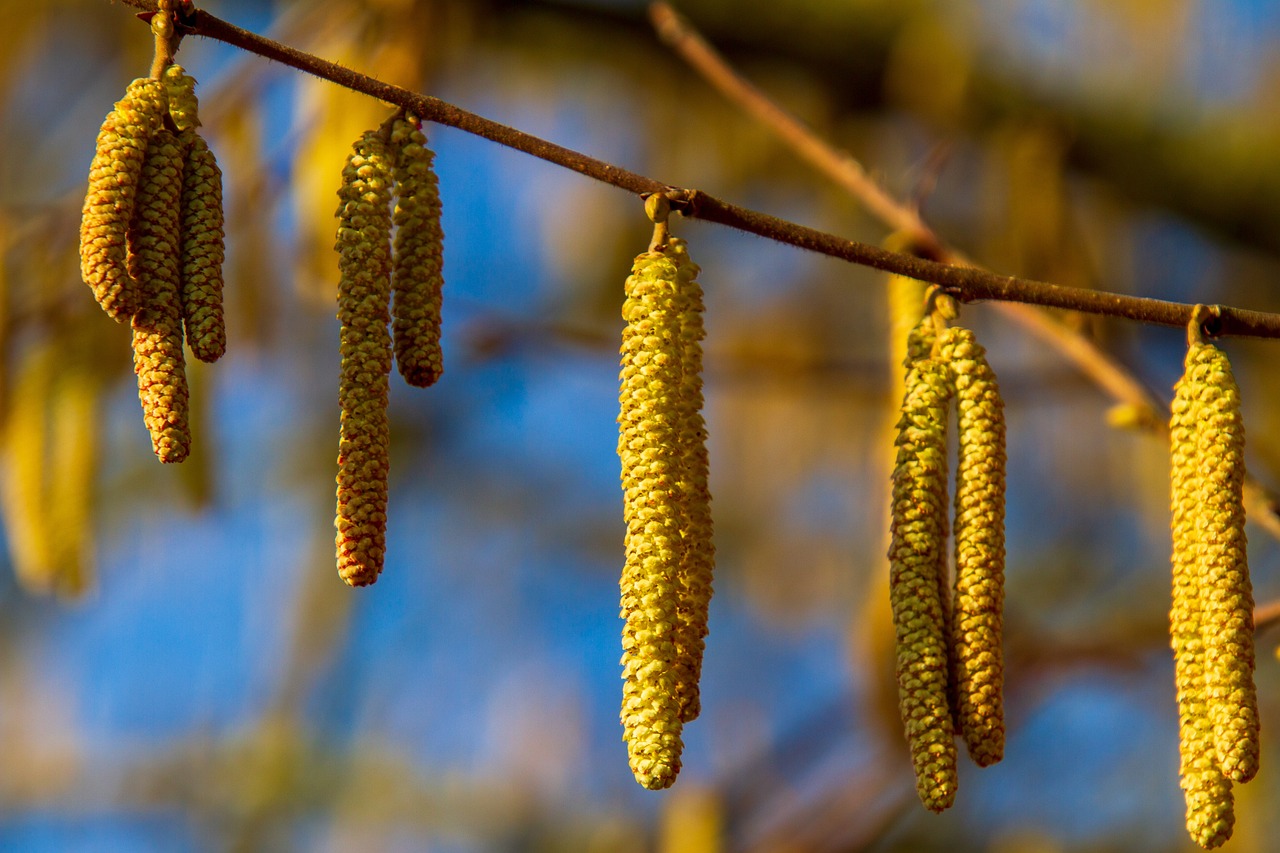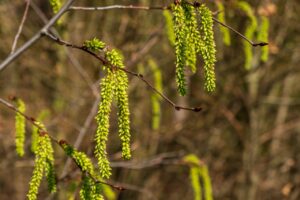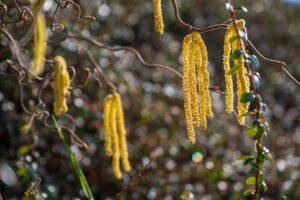Hazel
Overview
The Hazel plant, especially Witch Hazel species like Hamamelis virginiana and H. vernalis, are North American natives esteemed for their medicinal properties and garden aesthetics due to charming late winter blooms. These robust shrubs can tower up to 25 feet, favoring full to partial sun and moist, acidic soils. They offer a boost to pollinators with their early year blossoms1 2.

Characteristics
Known for its medicinal properties, attractive winter flowers, and ability to thrive in a range of soil conditions.
Region
Native to North America and commonly grown in temperate regions.
Natural Habitat
The Hazel plant is usually found in the wild in forests and along forest edges.
Cultivation
Prefers full to partial sun, moist well-draining acidic soil, tolerant of some alkalinity; cold hardy.
Uses and Benefits
Witch Hazel (Hamamelis virginiana) is a versatile shrub that offers both ornamental beauty and medicinal benefits. Its extracts are renowned for their soothing anti-inflammatory properties, making them a popular choice for treating skin irritations and minor wounds.
Native Americans have long recognized the healing potential of Witch Hazel, and their traditional uses have stood the test of time. Today, many skincare products incorporate Witch Hazel extracts to provide relief from various ailments, such as:
- Sunburns
- Insect bites
- Cuts and scrapes
- Bruises
- Hemorrhoids
In addition to its medicinal applications, Witch Hazel contributes to the ecosystem by providing an early food source for pollinators through its catkins. As the shrub blooms in late winter to early spring, it offers a vital resource for bees and other insects when few other plants are available.
When cultivating Witch Hazel in your garden, it’s essential to keep in mind its potential size and growth rate. This shrub can grow up to 12 inches annually, so ensure you have adequate space to accommodate its mature dimensions1. With proper care and attention, Witch Hazel will not only add visual interest to your garden but also provide you with a natural remedy for various skin concerns.

Cultivation Tips
Growing a Witch Hazel plant can be a deeply rewarding experience for any gardener. When choosing a location, be sure to provide enough space for your shrub to reach its full potential, as it can grow up to 25 feet tall and just as wide1. While Witch Hazel appreciates plenty of sunlight, if you live in a particularly hot climate, a bit of afternoon shade will be welcomed.
This hardy plant thrives in moist, well-draining soil and has a slight preference for acidity. However, it won’t be too fussy if the soil leans a bit alkaline2. Witch Hazel is quite cold-hardy and will delight you with beautiful blooms through the fall and into the winter, offering nearly two months of color and texture to your garden.
To ensure your Witch Hazel flourishes, keep these tips in mind:
- Provide ample space for growth
- Plant in a sunny location, with some afternoon shade in hot climates
- Ensure soil is moist and well-draining
- Expect annual growth of 4 to 12 inches4
With proper care, especially as it establishes its roots, your Witch Hazel will reward you with impressive displays season after season. Enjoy the unique beauty and charm of this remarkable shrub in your garden!
Seasonal Considerations
If you’re looking to add a touch of magic to your garden, consider growing a Witch Hazel plant (Hamamelis virginiana). This enchanting shrub is not only beautiful but also quite hardy, making it a great choice for both novice and experienced gardeners.
When it comes to seasonal considerations, Witch Hazel is a true gem. It’s one of the few plants that bloom in the fall and winter, providing a much-needed pop of color and texture to your garden when most other plants have gone dormant. You can expect to enjoy its stunning flowers for nearly two months, from late fall into the heart of winter1.
Despite its delicate appearance, Witch Hazel is surprisingly cold-hardy. It can withstand even the harshest of winters, making it an excellent choice for gardeners in colder climates. As the seasons change and spring arrives, you’ll notice your Witch Hazel putting on a bit of growth each year, typically around 4 to 12 inches4.
To ensure your Witch Hazel thrives through the seasons, keep these tips in mind:
- Choose a location with ample space, as this shrub can grow up to 25 feet tall and wide1.
- Provide plenty of sunlight, but if you live in a particularly hot climate, a bit of afternoon shade is appreciated.
- Plant in moist, well-draining soil with a slight preference for acidity, although Witch Hazel can tolerate slightly alkaline soil as well2.
With a little care and attention, especially as it establishes its roots, your Witch Hazel will reward you with stunning displays season after season. So why not add a touch of magic to your garden this year?

Issues and Troubleshooting
When cultivating Witch Hazel, be mindful of common issues that can impact its growth and health. Proper site selection is crucial, as Witch Hazels require ample space to spread and thrive. Choose a location that allows for their natural growth habit, ensuring they have room to reach their full potential.
Another potential problem is waterlogging due to poor soil drainage. Witch Hazels prefer moist, well-draining soil, and excessive moisture can lead to root rot. To prevent this, improve soil drainage by incorporating organic materials such as compost or leaf mold. This will help create a balanced growing environment that supports healthy root development.
While Witch Hazel is generally pest-resistant, it can occasionally fall victim to the Witch Hazel gall aphid. These aphids cause unsightly galls on the leaves, which can be a cosmetic concern. However, it’s important to note that these galls do not seriously harm the plant’s overall health4. If you notice aphids on your Witch Hazel, address the issue promptly by treating the plant with horticultural oils or insecticidal soaps.
To ensure your Witch Hazel thrives, follow these troubleshooting tips:
- Select a planting site that allows for ample growth and spread
- Improve soil drainage by incorporating organic materials
- Monitor for the presence of Witch Hazel gall aphids
- Treat aphid infestations promptly with horticultural oils or insecticidal soaps
By addressing these common issues and providing proper care, you can help your Witch Hazel become a resilient and charming addition to your garden, offering unique beauty and benefits for years to come.
History and Folklore
Witch Hazel, with its enchanting name and history, conjures images of ancient natural remedies and cultural lore. Native American tribes revered this plant, using its bark and leaves to soothe ailments2. The very essence of Witch Hazel seemed magical, not least for its ability to flower in the depths of winter—when the rest of the natural world appeared to be asleep.
This remarkable trait may have contributed to its mystique and the belief that the plant possessed special powers. The unique flowering period of Witch Hazel sets it apart from other plants, adding to its allure and the sense of wonder it inspires in those who encounter it.
The history of Witch Hazel is deeply entwined with the cultural practices and beliefs of various communities, particularly Native American tribes. These communities recognized the potential of the plant and harnessed its properties for medicinal purposes long before modern science could explain its benefits.
Gardeners today grow Witch Hazel not just for its medicinal benefits but for its unique aesthetic, harkening back to a time when plants were integral to both health and folklore1 2. The presence of Witch Hazel in a garden serves as a reminder of the deep connection between humans and nature, and the wisdom of those who came before us.
By cultivating Witch Hazel, modern gardeners can not only enjoy its beauty and potential health benefits but also feel a sense of connection to the rich history and cultural significance of this fascinating plant.
References
1. “Witch Hazel: Planting Witch Hazel in Your Garden – The Old Farmer’s Almanac.”, https://www.almanac.com/witch-hazel-garden
2. “Witch Hazel: Care and Growing Guide – The Spruce.”, https://www.thespruce.com/witch-hazel-growing-guide-5191457
3. “The Essential Guide to Hazel – Permaculture.”, https://www.permaculture.co.uk/articles/the-essential-guide-to-hazel/
4. “How to Grow and Care for Witch Hazel | Gardener’s Path.”, https://gardenerspath.com/plants/ornamentals/grow-witch-hazel/
Nicolas Duval
Nicolas is a passionate advocate for nature and the art of wildcrafting. His dedication shines through in Wildcraftia, a website he meticulously crafted to serve as a haven for nature enthusiasts worldwide. Driven by a deep appreciation for nature’s connection to humanity, Nicolas embarked on his journey in 2011 with SmokableHerbs, a platform showcasing his love for nature’s bounty. Building upon this foundation, he established Smokably, a thriving online store offering premium herbs and blends to a global audience.
